Where Did Breadfruit Originate from: Unearthing its Origin!
Breadfruit originated from the South Pacific region, specifically within Oceania, where it has been a fundamental part of the diet and culture for thousands of years.
Breadfruit is a product of the South Pacific, where it is deeply entrenched in the food traditions of Pacific Island communities.
It is:
The Polynesians were instrumental in spreading breadfruit during their sea voyages, and European explorers later introduced it to other tropical regions, such as the Caribbean.
The fruit’s adaptability makes it a valued component in various cuisines and agricultural systems.
Breadfruit’s journey from the South Pacific to global tables underscores its significance as a sustainable food resource.
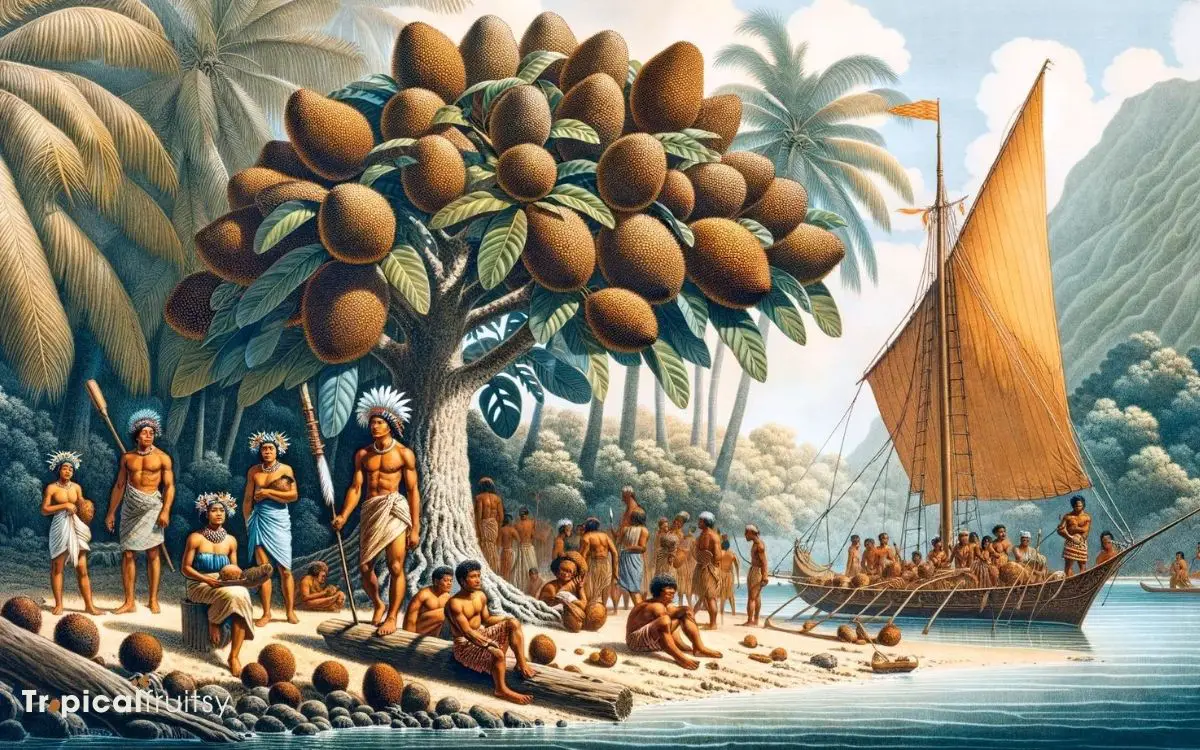
Key Takeaway
The Origins and Global Spread of Breadfruit
| Region | Significance of Breadfruit | Method of Propagation | Nutritional Value |
|---|---|---|---|
| South Pacific | Staple food and cultural importance for millennia. | Spread by ancient Polynesians. | High in carbohydrates and fiber. |
| Caribbean | Introduced by Europeans, now an essential part of diet. | Propagated by seed and root shoots. | Rich in vitamins and minerals. |
| Tropical regions | Valued for culinary versatility and agricultural benefits. | Cultivated in various ecosystems. | Provides a sustainable food source. |
Unveiling Breadfruit’s Origins

Breadfruit traces its origins to the lush rainforests of New Guinea, the Maluku Islands, and the Philippines, where it has been cultivated for thousands of years.
This staple food source, scientifically known as Artocarpus altilis, has played a pivotal role in the sustenance of various Pacific Island cultures.
Its propagation has been intricately linked with the maritime dispersal of peoples across Oceania.
The perennial nature of breadfruit, coupled with its high yield, has made it a cornerstone of traditional agroforestry systems.
Its genetic diversification through selective cultivation practices reveals a history of sophisticated agricultural methodologies employed by early societies.
Breadfruit’s diffusion from its center of origin is a testament to its adaptability and the ingenuity of ancient horticulturists.
Polynesian Navigators and Agriculture
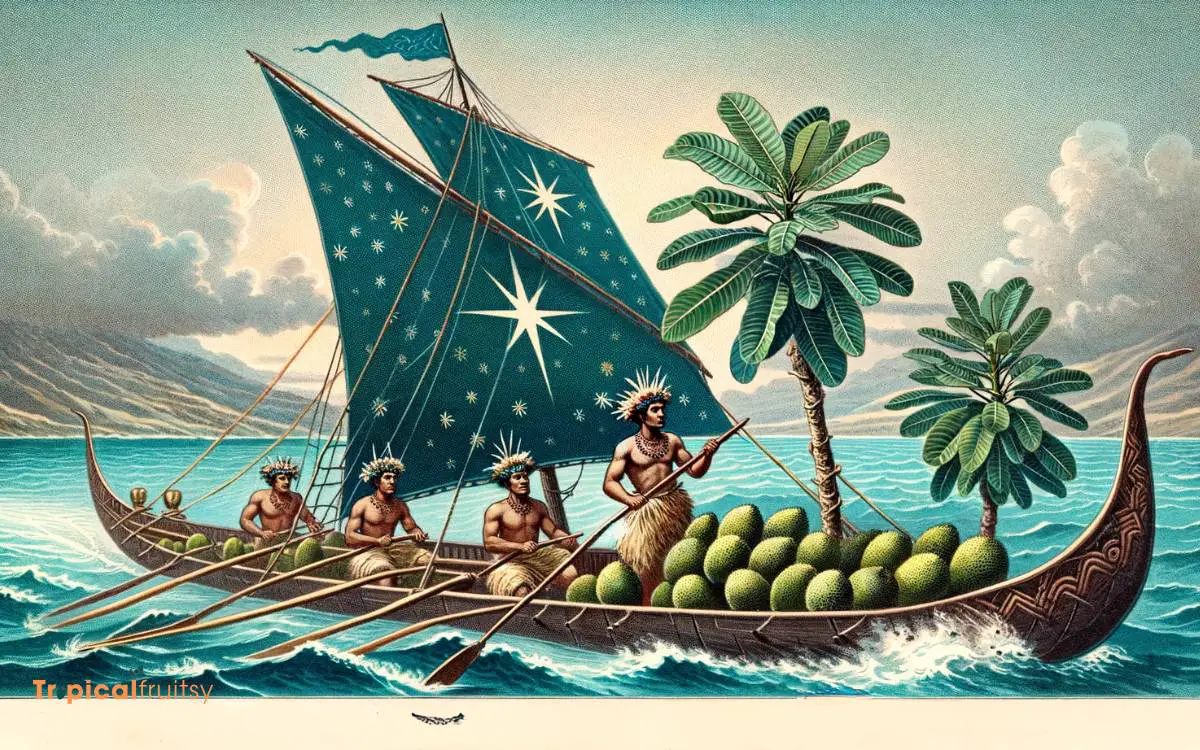
Polynesian navigators, renowned for their sophisticated voyaging skills, played a crucial role in the spread of breadfruit cultivation across the vast Pacific Ocean, intertwining agriculture with their maritime traditions.
Their deep understanding of wind patterns, ocean currents, and celestial navigation enabled them to transport breadfruit and other staple crops, facilitating the rise of stable communities.
| Aspect | Detail | Impact on Breadfruit Dissemination |
|---|---|---|
| Navigational Skill | Celestial, wind, current knowledge | Enabled long-distance voyaging |
| Crop Selection | Preference for robust, staple crops | Breadfruit became a primary choice |
| Cultural Exchange | Sharing of agricultural practices | Widespread cultivation techniques |
| Settlement Patterns | Establishment of new island communities | Breadfruit integrated into diets |
| Maritime Tradition | Legacy of exploration and expansion | Continuous spread of breadfruit |
This meticulous agricultural expansion was paralleled by a keen awareness of the ecological suitability for breadfruit cultivation.
The Breadfruit’s Nutritional Profile
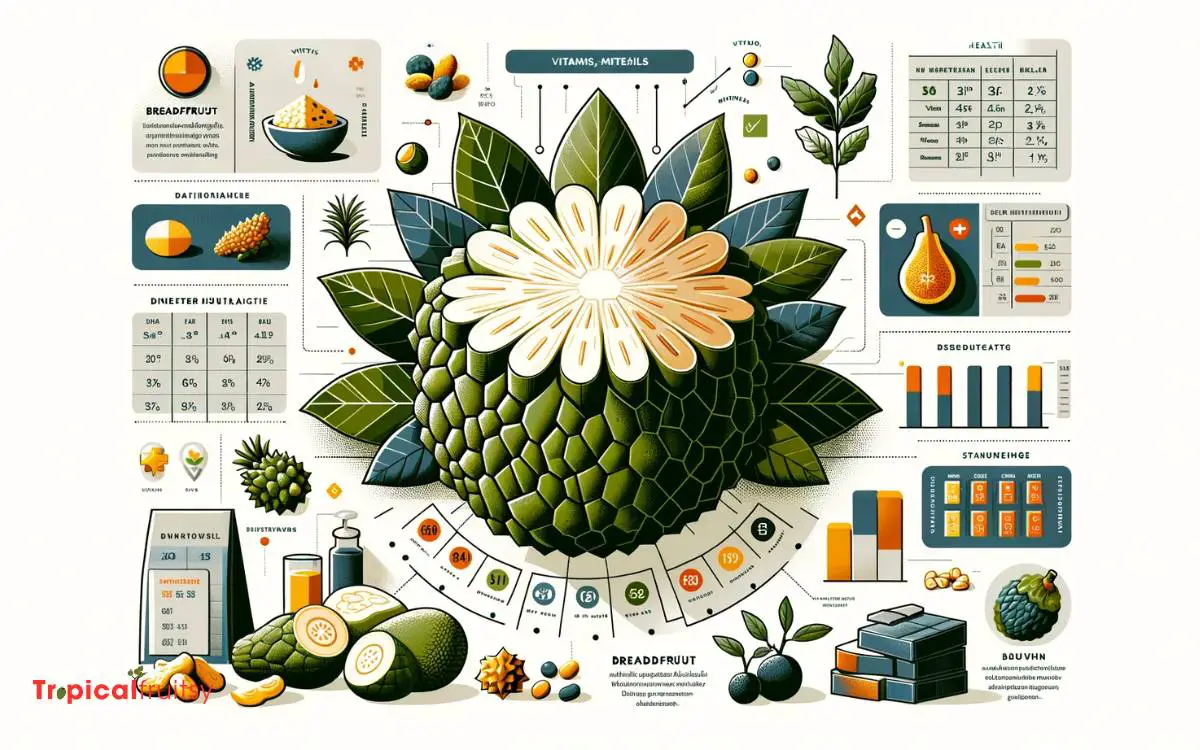
In addition to its significant role in Polynesian culture, the breadfruit offers a rich nutritional profile that has contributed to its status as a staple food in many tropical regions.
The fruit is a complex carbohydrate source, primarily providing energy through its high starch content.
It also contains modest amounts of protein and is low in fat, making it a balanced food item for daily consumption.
Vitamins present in breadfruit include vitamin C, thiamine, and niacin, all of which are essential for maintaining good health.
The fruit’s mineral composition boasts potassium, magnesium, and iron, which are crucial for electrolyte balance, muscle function, and oxygen transport, respectively. Dietary fiber is abundant, aiding in digestion and satiety.
This nutrient-dense food underscores its valuable contribution to the diet of the communities it sustains, leading to a deeper exploration of its cultural significance in Oceania.
Cultural Significance in Oceania

In examining the cultural landscape of Oceania, the breadfruit emerges not merely as a dietary mainstay but as an integral component of social and ritualistic practices.
Its use in traditional ceremonies underscores its symbolic weight in communal gatherings, reflecting a deep-seated reverence that transcends mere sustenance.
Furthermore, the tree and its fruit occupy a significant niche in Oceanic mythology, embodying themes of creation, fertility, and interconnectedness within many indigenous narratives.
Staple Pacific Diet
Breadfruit serves as a cornerstone of the traditional Pacific diet, reflecting its profound cultural significance across the islands of Oceania.
This staple food source has played a pivotal role in the sustenance and development of various Pacific Islander cultures.
Analytically assessing its cultural role reveals:
- Breadfruit is a perennial source of complex carbohydrates, contributing to food security.
- Its cultivation is deeply interwoven with traditional agroforestry practices unique to the region.
- The fruit’s versatility allows it to be prepared in numerous ways, reflecting local culinary traditions.
- Breadfruit symbolizes connection to the land and ancestral knowledge, reinforcing social cohesion.
These factors underscore breadfruit’s integral role in the cultural fabric of Oceania. This segue into its traditional ceremonial use further illuminates the fruit’s multifaceted importance.
Traditional Ceremonial Use
Beyond its everyday sustenance, breadfruit holds a revered position in numerous ceremonial practices throughout Oceania.
As a symbol of fertility and abundance, the fruit features prominently in rituals that are integral to the social and spiritual fabric of many Oceanic communities.
Its use is not merely alimentary but deeply embedded in the ceremonial economy, often serving as a prestigious offering to deities, a gesture of goodwill in intertribal exchanges, or as a central element in rites of passage.
The breadfruit tree itself, with its expansive canopy, is frequently considered a sacred entity, embodying the relationship between people and the divine, the living and their ancestors.
Consequently, the cultivation, harvest, and distribution of breadfruit are not purely horticultural activities but are suffused with cultural meaning and ritual significance.
Mythology and Symbolism
Numerous Oceanic myths and legends ascribe sacred significance to the breadfruit, often portraying it as a gift from the gods or a symbol of life and prosperity.
This deep-seated reverence is reflected in the rich tapestry of cultural narratives that imbue the breadfruit with profound symbolic value.
- Origin Myths: Many Pacific cultures hold that the breadfruit tree was created by their deities, symbolizing their benevolence and concern for human sustenance.
- Fertility and Abundance: Its prolific nature renders the breadfruit an emblem of fertility, linked to the prosperity of both land and people.
- Community and Sharing: Breadfruit’s traditional role in communal feasts underscores its association with social unity and generosity.
- Cyclical Renewal: The seasonal nature of breadfruit harvests echoes themes of regeneration and the perpetuity of life cycles in Oceanic societies.
In a scholarly examination, these symbolic dimensions offer insight into the cosmological frameworks and social structures of Oceania.
The Global Journey of Breadfruit
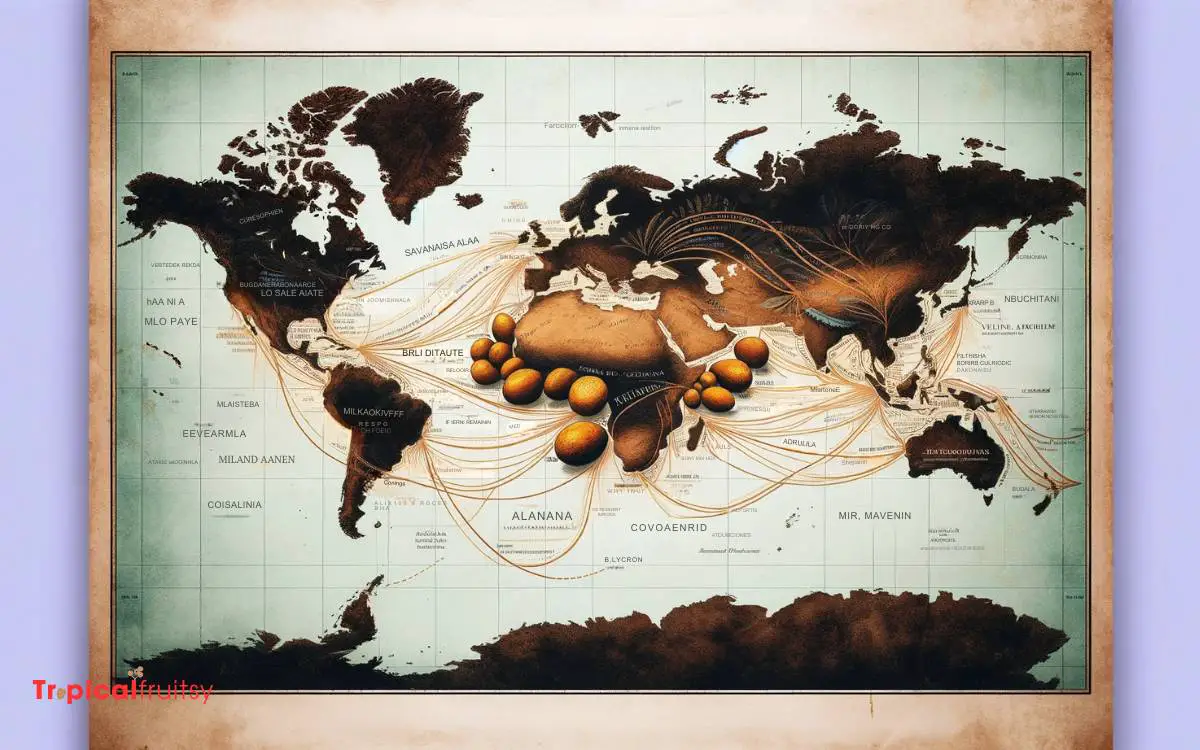
The dissemination of breadfruit from its Pacific Island origins to various tropical and subtropical regions around the world presents a compelling narrative of botanical migration and agricultural adaptation.
This global transit was facilitated by colonial expeditions and the subsequent establishment of breadfruit as a staple crop in plantation economies, particularly in the Caribbean.
The study of breadfruit’s proliferation reveals intricate patterns of human influence on plant distribution, reflecting both the intentional spread by explorers and the plant’s inherent adaptability to diverse climates.
Pacific Island Origins
Breadfruit, a staple crop with deep roots in the cultural and agricultural history of Oceania, initially thrived in the lush archipelagos of the Pacific Islands.
This region’s biodiversity offered the ideal environment for the domestication and proliferation of Artocarpus altilis, the scientific name for breadfruit.
The dispersion of breadfruit from its Pacific cradle followed ancient voyaging routes, illustrating a facet of the Austronesian expansion.
To comprehend the significance of breadfruit in the Pacific, consider the following aspects:
- Breadfruit is entwined with traditional agroforestry systems, which are a testament to Pacific Islanders’ sophisticated ecological knowledge.
- It symbolizes the rich botanical and cultural exchange inherent in the inter-island trade networks.
- The fruit’s versatility as a food source underscores its integral role in traditional diets.
- Breadfruit cultivation reflects adaptation strategies to diverse island microclimates, showcasing a harmonious human-environment interaction.
Worldwide Cultivation Spread
Having originated in the Pacific Islands, breadfruit’s cultivation eventually expanded across the globe, facilitated by seafaring explorers and colonial trade routes.
This expansion can be analytically charted through significant historical voyages and the establishment of breadfruit in various tropical regions.
The following table succinctly encapsulates key milestones in this global journey:
| Region | Mode of Introduction | Notable Impact |
|---|---|---|
| Caribbean | HMS Bounty, 18th century | Staple food, cultural significance |
| Southeast Asia | Austronesian migration | Diversified agriculture, sustenance |
| Africa | Slave trade, colonial era | Erosion control, food security |
This scholarly review underscores the adaptive nature of breadfruit cultivation, reflecting its integration into diverse ecosystems and societies.
Breadfruit’s Introduction to the Caribbean
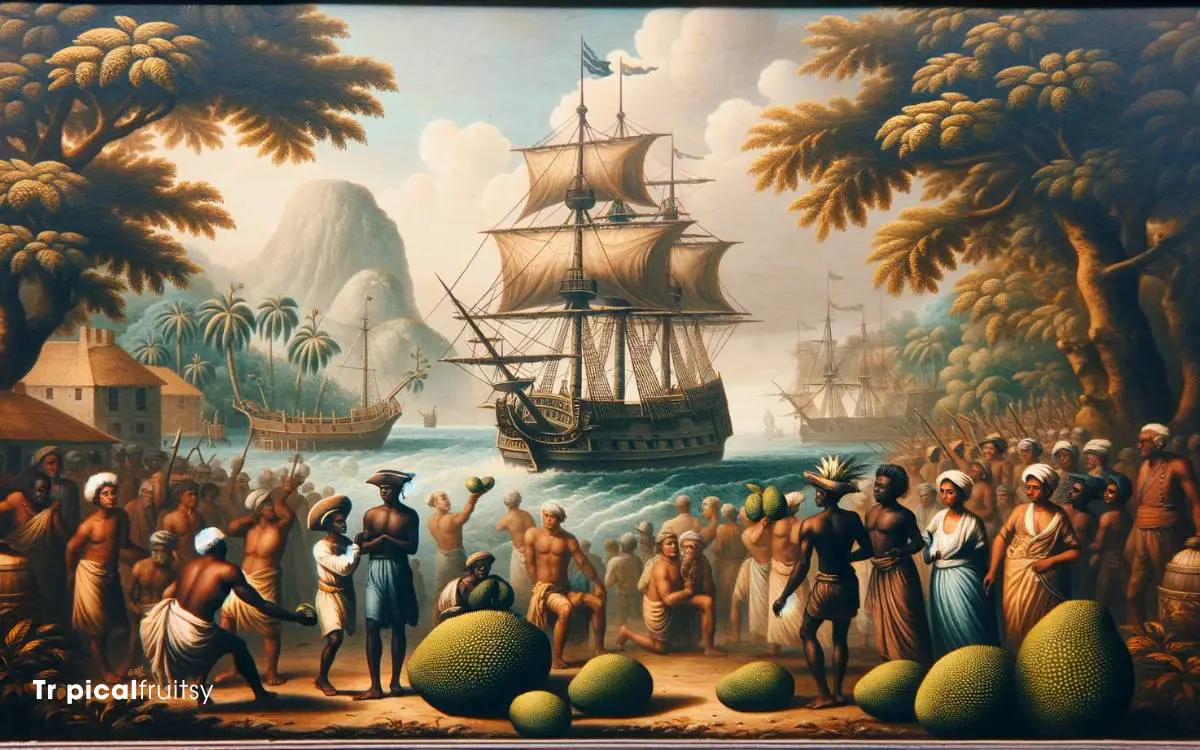
Amidst the vast voyages of the 18th century, breadfruit was introduced to the Caribbean as part of a colonial effort to provide cheap, high-energy food for slaves.
This strategic importation aimed to sustain the labor force with minimal expense while maximizing plantation profits.
The transplantation of breadfruit to these tropical islands entailed both deliberate planning and botanical acclimatization.
- Captain William Bligh’s Mission: Commissioned by the British government, his infamous 1787 voyage on the HMS Bounty sought to transport breadfruit plants from Tahiti to the Caribbean.
- Mutiny and Delay: The well-known mutiny led by Fletcher Christian disrupted the initial mission, delaying breadfruit’s Caribbean debut until Bligh’s successful second voyage in 1793.
- Cultivation and Adaptation: Breadfruit thrived in the favorable Caribbean climate, adapting quickly to its new environment, which mirrored its native Polynesian habitat.
- Impact on Diets: It swiftly became a staple food source for enslaved populations, altering the dietary landscape of the Caribbean.
Modern Cultivation and Uses

How has the cultivation of breadfruit evolved since its historical origins, and what are its contemporary uses globally?
Modern breadfruit cultivation extends beyond its native range of Oceania and the Malay Peninsula, reflecting a global diversification of agricultural practices.
Contemporary cultivation leverages both traditional methods and scientific advancements to optimize yield and adaptability.
Breadfruit is now recognized for its significant nutritional contributions and its potential role in food security, especially in tropical and subtropical regions where it thrives.
| Region | Cultivation Practices | Primary Uses |
|---|---|---|
| Oceania | Traditional agroforestry | Staple food, cultural dishes |
| Caribbean | Smallholder farms, intercropping | Nutrition programs, fresh consumption |
| Africa | Research-driven propagation | Food security, climate change resilience |
In-depth analyses reveal breadfruit’s versatility, not only as a food source but also in applications such as livestock feed, timber, and even as a component in the development of biodegradable materials, underscoring its multifaceted importance in the modern era.
What is the connection between the origin of breadfruit and why it is called breadfruit?
The origin of breadfruit can be traced back to the Pacific Islands, where it has been a staple food for centuries. The name “breadfruit” comes from the starchy texture of the fruit when it is cooked, which resembles freshly baked bread. This is why breadfruit is named as such.
History of Breadfruit in the Caribbean
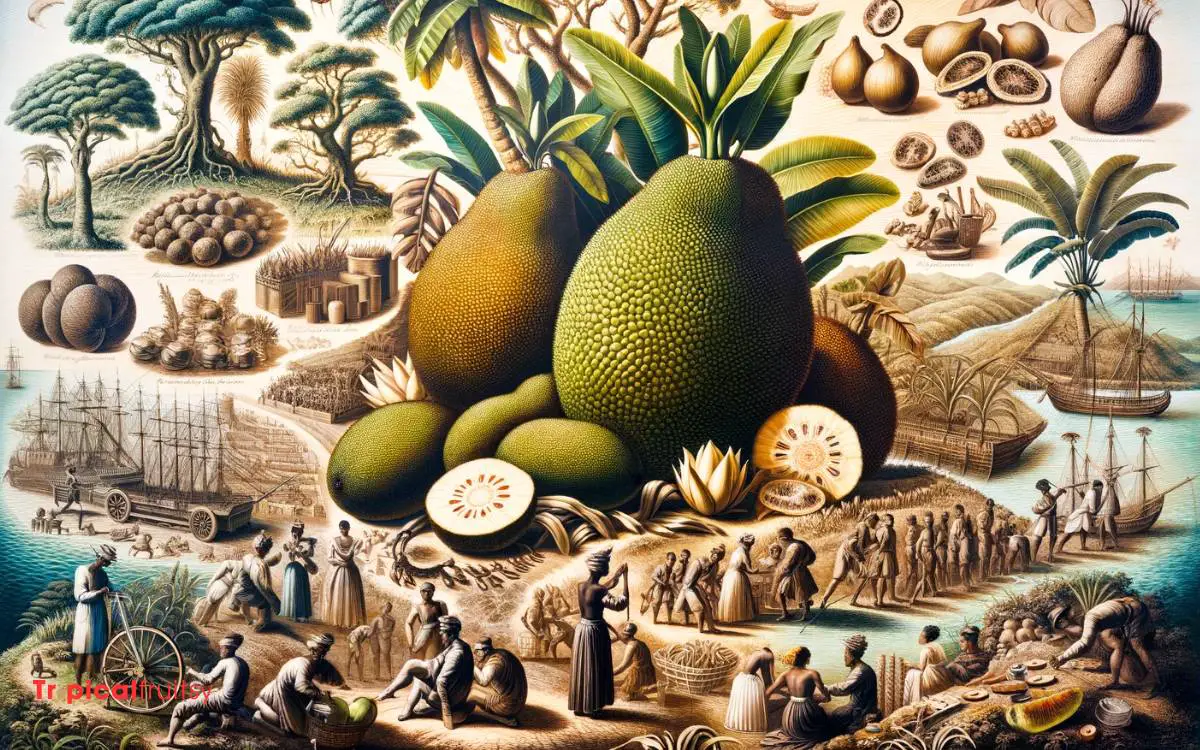
Breadfruit (Artocarpus altilis) has a rich history in the Caribbean, playing a significant role in the region’s culture, cuisine, and economy.
The breadfruit tree is native to the Malay Peninsula and western Pacific islands but was introduced to the Caribbean by Captain William Bligh in the late 18th century.
Captain Bligh, an officer in the British Royal Navy, was tasked with transporting breadfruit plants from Tahiti to the Caribbean to provide a cheap and easily cultivated food source for the enslaved population working on plantations.
This expedition was part of a broader effort to find alternative food sources for the Caribbean colonies.
In 1787, Bligh set sail on the HMS Bounty with a cargo of breadfruit plants. The journey was not without challenges, and the most well-known incident was the infamous mutiny led by Fletcher Christian in 1789.
Despite the mutiny, some of the breadfruit plants survived the ordeal, and Bligh successfully transported them to the Caribbean on another ship.
Upon arrival, the breadfruit was introduced to various Caribbean islands, where it thrived in the tropical climate.
The plant quickly adapted to the local environment and became a staple food source for many Caribbean communities.
Its starchy, versatile fruit provided a valuable dietary supplement, offering an alternative to traditional staples like yams and cassava.
Breadfruit trees are well-suited to the Caribbean climate, and they can produce large quantities of fruit with minimal care.
The tree’s ability to thrive in diverse soil conditions and resist pests made it an attractive option for plantation owners and small-scale farmers alike.
Over time, breadfruit became an integral part of Caribbean cuisine. It is used in a variety of dishes, both savory and sweet.
The fruit can be roasted, fried, boiled, or turned into flour for baking. It is also a key ingredient in many traditional recipes and has contributed to the culinary diversity of the region.
In addition to its role in food security and culinary traditions, breadfruit has had economic implications in the Caribbean.
The cultivation and export of breadfruit have provided income opportunities for farmers and contributed to the region’s agricultural economy.
Today, breadfruit remains a significant part of Caribbean culture and cuisine, reflecting the historical impact of Captain Bligh’s expedition and the successful introduction of this versatile and resilient fruit to the region.
Conclusion
Breadfruit’s odyssey from its Polynesian cradle to global tables encapsulates a narrative of ecological adaptation and cultural integration.
Serving as a botanical ambassador, this versatile staple has woven a rich tapestry of nutritional sustenance and agricultural significance across continents.
As it continues to flourish in tropical soils, breadfruit stands not only as a testament to ancestral ingenuity but also as a beacon of potential in addressing contemporary food security challenges.






